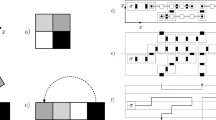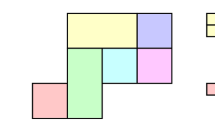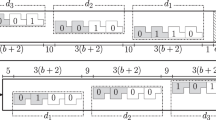Abstract
We consider problems in variations of the two-handed abstract Tile Assembly Model (2HAM), a generalization of Erik Winfree’s abstract Tile Assembly Model (aTAM). In the latter, tiles attach one-at-a-time to a seed-containing assembly. In the former, tiles aggregate into supertiles that then further combine to form larger supertiles; hence, constructions must be robust to the choice of seed (nucleation) tiles. We obtain three distinct temperature-1 results in two 2HAM variants whose aTAM siblings are well-studied. In the first variant, called the restricted glue 2HAM (rg2HAM), glue strengths are restricted to \(-\,1\), 0, or 1. We prove this model is Turing universal, overcoming undesired growth by breaking apart undesired computation assembly via repulsive forces. In the second 2HAM variant, the 3D 2HAM (3D2HAM), tiles are (three-dimensional) cubes. We prove that assembling a (roughly two-layer) \(n \times n\) square in this model at temperature 1 is possible with \(O(\log ^2{n})\) tile types. The construction uses “cyclic, colliding” binary counters, and assembles the shape non-deterministically. Finally, we prove that there exist 3D2HAM systems that only assemble infinite aperiodic shapes.

























Similar content being viewed by others
Explore related subjects
Discover the latest articles, news and stories from top researchers in related subjects.Notes
Such a distinction is only needed in two-handed models, where the seed cannot be used as a “reference point”.
References
Adleman L, Cheng Q, Goel A, Huang MD (2001) Running time and program size for self-assembled squares. In: Proceedings of the 33rd annual ACM symposium on theory of computing (STOC), pp 740–748
Barish RD, Schulman R, Rothemund PW, Winfree E (2009) An information-bearing seed for nucleating algorithmic self-assembly. Proc Natl Acad Sci 106(15):6054–6059
Berger R (1966) The undecidability of the domino problem. Mem Am Math Soc 66:1–72
Cannon S, Demaine ED, Demaine ML, Eisenstat S, Patitz MJ, Schweller R, Summers SM, Winslow A (2013) Two hands are better than one (up to constant factors): self-assembly in the 2HAM vs. aTAM. In: Proceedings of 30th international symposium on theoretical aspects of computer science (STACS), LIPIcs, vol 20. Schloss Dagstuhl, pp 172–184
Chen HL, Doty D, Manuch J, Rafiey A, Stacho L (2015) Pattern overlap implies runaway growth in hierarchical tile systems. In: Arge L, Pach J (eds) 31st international symposium on computational geometry (SoCG), LIPIcs, vol 34. Schloss Dagstuhl, pp 360–373
Chen HL, Schulman R, Goel A, Winfree E (2007) Reducing facet nucleation during algorithmic self-assembly. Nano Lett 7(9):2913–2919
Cook M, Fu Y, Schweller RT (2011) Temperature 1 self-assembly: deterministic assembly in 3D and probabilistic assembly in 2D. In: Proceedings of the 22nd ACM-SIAM symposium on discrete algorithms, SODA’11, pp 570–589
Demaine ED, Demaine ML, Fekete SP, Ishaque M, Rafalin E, Schweller RT, Souvaine DL (2008) Staged self-assembly: nanomanufacture of arbitrary shapes with \({O}(1)\) glues. Nat Comput 7(3):347–370
Doty D (2016) Producibility in hierarchical self-assembly. Nat Comput 15(1):41–49
Doty D, Patitz MJ, Summers SM (2011) Limitations of self-assembly at temperature 1. Theor Comput Sci 412:145–158
Fekete SP, Hendricks J, Patitz MJ, Rogers TA, Schweller RT (2015) Universal computation with arbitrary polyomino tiles in non-cooperative self-assembly. In: Proceedings of the 25th ACM-SIAM symposium on discrete algorithms, SODA’15. SIAM, pp 148–167
Furcy D, Micka S, Summers SM (2017) Optimal program-size complexity for self-assembled squares at temperature 1 in 3D. Algorithmica 77(4):1240–1282
Furcy D, Summers SM (2015) Optimal self-assembly of finite shapes at temperature 1 in 3D. In: Combinatorial optimization and applications (COCOA), LNCS, vol 9486, pp 138–151
Goodman-Strauss C (2000) Open questions in tiling. http://comp.uark.edu/~strauss/papers/survey.pdf
Grünbaum B, Shephard GC (1987) Tilings and patterns. W.H. Freeman and Company, London
Hendricks J, Patitz MJ, Rogers TA, Summers SM (2014) The power of duples (in self-assembly): it’s not so hip to be square. In: Proceedings of the 20th internation confereonce on computing and combinatorics (COCOON), pp 215–226
Meunier PE, Patitz MJ, Summers SM, Theyssier G, Woods D (2014) Intrinsic universality in tile self-assembly requires cooperation. In: Proceedings of the 25th symposium on discrete algorithms (SODA), pp 752–771
Padilla JE, Patitz MJ, Pena R, Schweller RT, Seeman NC, Sheline R, Summers SM, Zhong X (2014) Asynchronous signal passing for tile self-assembly: fuel efficient computation and efficient assembly of shapes. Int J Found Comput Sci 25:459 (Special Issue for UCNC 2013 Full Papers)
Patitz MJ, Schweller RT, Summers SM (2011) Exact shapes and turing universality at temperature 1 with a single negative glue. In: DNA computing and molecular programming, LNCS, vol 6937. Springer, pp 175–189. https://link.springer.com/chapter/10.1007/978-3-642-23638-9_15
Rothemund PWK, Winfree E (2000) The program-size complexity of self-assembled squares (extended abstract). In: Proceedings of the 32nd ACM symposium on theory of computing (STOC), pp 459–468
Schulman R (2007) The self-replication and evolution of DNA crystals. Ph.D. thesis, California Institute of Technology
Schulman R, Winfree E (2007) Synthesis of crystals with a programmable kinetic barrier to nucleation. Proc Natl Acad Sci 104(39):15236–15241
Schulman R, Winfree E (2009) Programmable control of nucleation for algorithmic self-assembly. SIAM J Comput 39(4):1581–1616
Seeman NC (1982) Nucleic-acid junctions and lattices. J Theor Biol 99:237–247
Socolar JES, Taylor JM (2011) An aperiodic hexagonal tile. J Comb Theory Ser A 118(8):2207–2231
Soloveichik D, Winfree E (2007) Complexity of self-assembled shapes. SIAM J Comput 36(6):1544–1569
Winfree E (1998) Algorithmic self-assembly of DNA. Ph.D. thesis, Caltech
Acknowledgements
Matthew J. Patitz: This author’s research was supported in part by National Science Foundation Grants CCF-1117672, CCF-1422152, and CAREER-1553166. Robert Schweller: This author’s research was supported in part by National Science Foundation Grants CCF-1117672 and CCF-1555626. Trent A. Rogers: This author’s research was supported by the National Science Foundation Graduate Research Fellowship Program under Grant No. DGE-1450079, and National Science Foundation Grant CCF-1422152
Author information
Authors and Affiliations
Corresponding author
Additional information
An extended abstract of this work that omitted several proofs and details was previously published in DNA Computing and Molecular Programming, LNCS, vol. 9818, pp. 98–113, Springer International Publishing (2016).
Rights and permissions
About this article
Cite this article
Patitz, M.J., Schweller, R., Rogers, T.A. et al. Resiliency to multiple nucleation in temperature-1 self-assembly. Nat Comput 17, 31–46 (2018). https://doi.org/10.1007/s11047-017-9662-x
Published:
Issue Date:
DOI: https://doi.org/10.1007/s11047-017-9662-x




